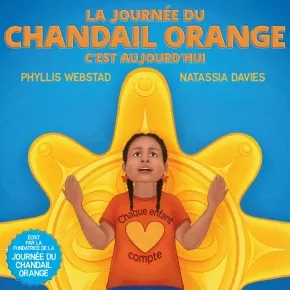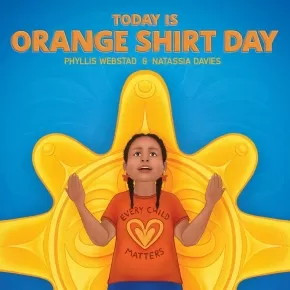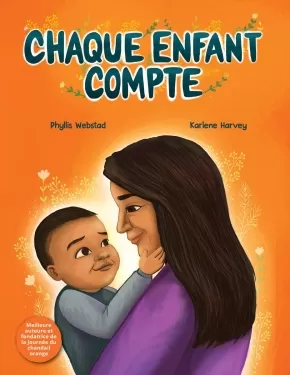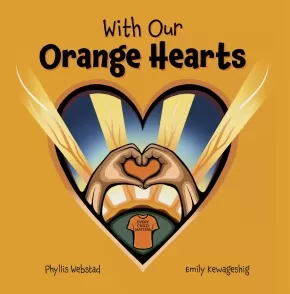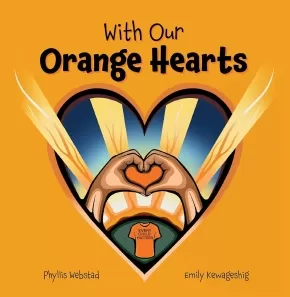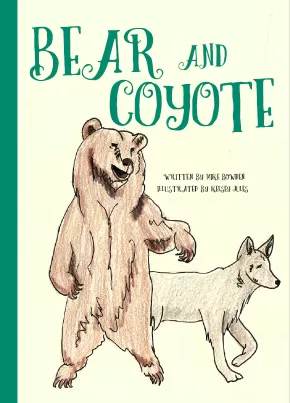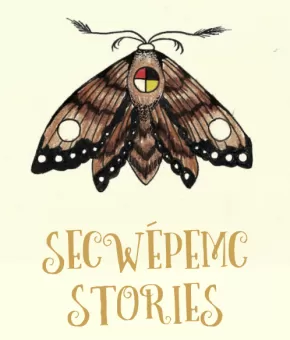
Secwepemc (Shuswap)
1
-
15
of
18 Results;
Sort By
Go To
of 2
La Journée du chandail orange, c'est aujourd'hui (BB)
$14.95
Artists:
Format:
Board Book
Text Content Territories:
Indigenous Canadian; First Nations; Salish; Interior Salish; Secwepemc (Shuswap); Stswecem'c Xgat'tem;
Grade Levels: Preschool;
ISBN / Barcode: 9781778540677
Synopsis:
Synopsis:
Aujourd'hui, nous nous rassemblons
Aujourd'hui, nous écoutons
Aujourd'hui, nous apprenons
Aujourd'hui, nous ouvrons nos coeurs
Une première conversation sur l'importance de la Journée du chandail orange – Chaque enfant compte et permet aux tout-petits de savoir ce qu'ils peuvent s'attendre à voir et à faire lors de la Journée du chandail orange – Journée nationale pour la vérité et la réconciliation.
Un tout-carton authentique et adapté à l'âge, conçu pour les enfants de 0 à 3 ans, écrit par la fondatrice du mouvement La Journée du chandail orange et auteur du livre d'images primé « Chaque enfant compte ».
La Journée du chandail orange est reconnue chaque année le 30 septembre pour honorer les survivants des pensionnats indiens, leurs familles et les enfants qui ne sont pas rentrés.
Educator Information
Recommended for ages 3 and under.
This book is available in English: Today is Orange Shirt Day (BB)
Additional Information
24 pages | 7.00" x 7.00" | Board book
Today is Orange Shirt Day (BB)
$13.95
Artists:
Format:
Board Book
Text Content Territories:
Indigenous Canadian; First Nations; Salish; Interior Salish; Secwepemc (Shuswap); Stswecem'c Xgat'tem;
Grade Levels: Preschool;
ISBN / Barcode: 9781778540363
Synopsis:
Synopsis:
Today, we gather together Today, we listen Today, we learn Today, we open our hearts
A first conversation about the importance of Orange Shirt Day - Every Child Matters and what little ones can expect to see and do on Orange Shirt Day - The National Day for Truth and Reconciliation.
An authentic, age-appropriate touch-and-feel board book designed for ages 0-3, written by the founder of the Orange Shirt Day movement and author of award-winning picture book Every Child Matters.
Orange Shirt Day is a day recognized annually on September 30th to honour Residential School Survivors, their families, and the children who did not come home.
Awards
- Silver IPPA Book Award Winner (First Nations/Indigenous Communities category)
Educator Information
Recommended for ages 0 to 3.
This book is available in French: La Journée du chandail orange, c'est aujourd'hui (BB)
Additional Information
24 pages | 7.00" x 7.00" | Board book
Chaque enfant compte
$24.99
Format:
Hardcover
Text Content Territories:
Indigenous Canadian; First Nations; Inuit; Métis;
ISBN / Barcode: 9781778540172
Synopsis:
Synopsis:
Apprenez ce que veut dire la phrase « Chaque enfant compte ». Phyllis Webstad, la fondatrice de la Journee du chandail orange, presente un apercu de ce mouvement sincere. Chaque enfant compte honore l'histoire et la resilience des peuples autochtones sur l'Ile de la Tortue et nous permet de tous cheminer vers la verite et la reconciliation. Si vous etes un survivant des pensionnats ou un survivant intergenerationnel, vous comptez. Pour les enfants qui ne sont pas revenus a la maison, vous comptez. L'enfant en chacun de nous compte. Chaque enfant compte.
Educator Information
Recommended for ages 6 to 10.
Find the accompanying Teacher Lesson Plan here: Chaque enfant compte plan de cours
This book is available in English: Every Child Matters
Additional Information
44 pages | 8.62" x 11.18" | Hardcover
Every Child Matters
$24.99
Format:
Hardcover
Text Content Territories:
Indigenous Canadian; First Nations; Inuit; Métis;
ISBN / Barcode: 9781778540165
Synopsis:
Synopsis:
Learn the meaning behind the phrase, ‘Every Child Matters.'
Orange Shirt Day founder, Phyllis Webstad, offers insights into this heartfelt movement.
Every Child Matters honours the history and resiliency of Indigenous Peoples on Turtle Island and moves us all forward on a path toward Truth and Reconciliation.
If you're a Residential School Survivor or an Intergenerational Survivor - you matter. For the children who didn't make it home - you matter. The child inside every one of us matters. Every Child Matters.
Reviews
"Every Child Matters speaks to all Indigenous Peoples - past and present - whose lives have been impacted by the residential school system. Phyllis and Karlene beautifully honour the unity, strength and resolve shared by Survivors, their families and their communities. Residential schools took our children and tried to break their vibrant spirits. With this book, the children of today can learn the truths of this history and how they can play a part in making sure every child matters." – Stephanie Scott, Executive Director of the National Center for Truth and Reconciliation
“…a brilliantly illustrated and meticulously written narrative. It is a must read.” - Chief Dr. Robert Joseph, Gwawaenuk, Elder, Reconciliation Canada
Educator Information
Recommended for ages 6 to 10.
Find the accompanying Teacher Lesson Plan resource HERE!
This book is available in French: Chaque enfant compte
Additional Information
44 pages | 8.50" x 11.00" | Hardcover
Orange Shirt Day: September 30th: Revised Edition
$32.99
Format:
Hardcover
Text Content Territories:
Indigenous Canadian; First Nations; Inuit; Métis;
ISBN / Barcode: 9781778540141
Synopsis:
Synopsis:
Orange Shirt Day, observed annually on September 30th, is also known as the National Day for Truth and Reconciliation. It is an official day to honour Residential School Survivors and their families, and to remember the children who did not come home. What was initially envisioned as a way to keep the conversations going about all aspects of Residential Schools in Williams Lake and the Cariboo Region of British Columbia, Canada, has now expanded into a movement across Turtle Island and beyond. Orange Shirt Day: September 30th aims to create champions who will walk a path of reconciliation and promote the message that 'Every Child Matters'. This award-winning book explores a number of important topics including the historical, generational, and continual impacts of Residential Schools on Indigenous Peoples, the journey of the Orange Shirt Day movement, and how you can effectively participate in the National Day for Truth and Reconciliation. With end of chapter reflection questions and a series of student art submissions, readers are guided to explore how they, and others, view and participate in Residential School reconciliation.
Awards
- 2021 First Nation Communities Read 2021 Winner
Educator Information
Recommended Ages: 10+
Orange Shirt Day was inspired by the story of a survivor named Phyllis Webstad. When Phyllis was 6 years old she went to residential school for the first time wearing a brand new shiny orange shirt. When she arrived at the school her shirt was taken away and never to be seen again. To Phyllis the colour orange was a symbol that she did not matter. Today she has learned to accept the colour and even have fun with it and now the orange shirt has become a symbol of hope and reconciliation. By wearing an orange shirt on Orange Shirt Day, you make a powerful statement that residential schools were wrong and commit to the concept that EVERY CHILD MATTERS.
The Orange Shirt Society is a non-profit organization with its home in Williams Lake, BC where Orange Shirt Day began in 2013. The society has both Indigenous and non-Indigenous board members, and one of the editors of this book, Phyllis Webstad, is Indigenous. Therefore, the Authentic Indigenous Text label has been applied. It is up to readers to determine if this book is authentic for their purposes.
This is the Revised 2023, 2nd Edition
Additional Information
156 pages | 8.23" x 11.06" | Revised, 2nd Edition
Powwow Dancing With Family (PB)
 $16.95
$16.95

Artists:
Format:
Paperback
Text Content Territories:
Indigenous Canadian; First Nations; Salish; Interior Salish; Secwepemc (Shuswap);
ISBN / Barcode: 9781771746281
Synopsis:
Synopsis:
Drumming, singing, and dancing are all part of being at a Powwow. Perry and his family travel all over North America to participate in these family and community gatherings. Join Perry’s two boys as they share their treasured memories of being at Powwows with their family and learning how to dance.
Reviews
“Lavishly illustrated with photographs, vivid sketches, and ledger art, Powwow Dancing With Family provides a detailed description of each stage of the Powwow, historical and contemporary aspects of the Powwow, and pays homage to Indigenous culture and customs. This informative resource will support studies of Indigenous culture, history, traditions, community, art, and family lifestyle.” – ERAC Review, May 2019
Educator Information
Includes three pages of educational material on Powwows with information found under these headings:
- What is a Powwow?
- Powwow Regalia
- Powwow Dances
About Perry Smith's Ledger Art:
Ledger Art is an art form that was developed in the mid 1800s to early 1900s by the Plains First Nations during a time when reserves were being established across North America. The ledger books were acquired in trade, war, or raids. New art supplies were also introduced: coloured pencils, crayons, and occasionally water paints. The new supplies were favoured by artists over the traditional bone and stick brushes. Many of the artworks within these ledger books display a traditional way of life, before assimilation. Today these artworks are greatly valued for the historical perspective that they offer.
Additional Information
32 pages | 8" x 8" | ISBN: 9781771746281 | Paperback
With Our Orange Hearts (HC)
$16.99
Format:
Hardcover
Text Content Territories:
Indigenous Canadian; First Nations; Salish; Interior Salish; Secwepemc (Shuswap); Stswecem'c Xgat'tem; Inuit; Métis;
ISBN / Barcode: 9781778540257
Synopsis:
Synopsis:
Listening is a first step towards reconciliation. It's never too early to start. "Every child matters, including you and me. With our orange hearts, we walk in harmony." As a young child, your little world can be full of big feelings. In this book, I, Phyllis Webstad, founder of Orange Shirt Day, show how sharing my story with the world helped me to process my feelings. My true story encourages young children to open their hearts when others share their feelings and be more comfortable sharing their own feelings, too.
Educator Information
Recommended for ages 2 to 6.
This book is available in French in paperback: Avec nos coeurs oranges
This book is available in English in paperback: With Our Orange Hearts (PB)
Additional Information
24 pages | 8.15" x 8.25" | Hardcover
With Our Orange Hearts (PB)
$10.99
Format:
Paperback
Text Content Territories:
Indigenous Canadian; Inuit; First Nations; Salish; Interior Salish; Secwepemc (Shuswap); Stswecem'c Xgat'tem; Métis;
ISBN / Barcode: 9781989122976
Synopsis:
Synopsis:
"Every child matters, including you and me. With our orange hearts, we walk in harmony." As a young child, your little world can be full of big emotions. In this book, I, Phyllis Webstad, founder of Orange Shirt Day, show that sharing my story with the world helped me to process my feelings. My true orange shirt story encourages young children to open their hearts and listen as others share their feelings, and to be more comfortable sharing their own feelings too. Listening is a first step towards reconciliation. It's never too early to start.
Educator Information
Recommended for ages 2 to 6.
This book is available in French in paperback: Avec nos coeurs oranges
This book is available in English in hardcover: With Our Orange Hearts (HC)
Additional Information
24 pages | 8.00" x 8.00" | Paperback
Hockey with Dad
$19.95
Artists:
Format:
Hardcover
Text Content Territories:
Indigenous Canadian; First Nations; Salish; Interior Salish; Secwepemc (Shuswap);
ISBN / Barcode: 9781987915808
Synopsis:
Synopsis:
She shoots, she scores!
Big Sister's hockey team has worked hard toward the most important game of the season. When the team goalie gets sick, Little Brother excitedly steps onto the ice to play in the Championship game. He always wanted to be part of the lineup, where Big Sister is the ace forward. The closer the game gets, the more nervous he becomes. Can he and Sister make the community proud? He must rely on his family's long history of playing hockey, the wisdom of Grandpa, Dad, Big Sister, and the Secwépemc cultural values they impart.
Additional Information
32 pages | 9.50" x 8.50"
Orange Shirt Day Book Package
$92.99
Artists:
Text Content Territories:
Indigenous Canadian; First Nations; Salish; Interior Salish; Secwepemc (Shuswap); Stswecem'c Xgat'tem;
ISBN / Barcode: 9781989122808
Synopsis:
Synopsis:
A collection of authentic Orange Shirt Day books from the founder of the Orange Shirt Day movement, Phyllis Webstad. Package includes four books and three accompanying lesson plans, The Orange Shirt Story, Phyllis's Orange Shirt, Orange Shirt Day and Beyond the Orange Shirt Story.
Educator Information
Includes picture books for children, as well as books for young adults. Review individual titles for more information about each include:
Additional Information
9.00" x 12.00"
Bear and Coyote (PB)
 $11.95
$11.95

Artists:
Format:
Paperback
Text Content Territories:
Indigenous Canadian; First Nations; Salish; Interior Salish; Secwepemc (Shuswap);
ISBN / Barcode: 9781771745703
Synopsis:
Synopsis:
Kenkéknem (Bear) and Sek̓lép (Coyote) are both busy preparing for the long winter months ahead. Kenkéknem eats berries while Sek̓lép dries salmon and bakes Bannock. They have always done this separately and do not want to share with each other. However, this year Kenkéknem is curious about what Sek̓lép is doing, and he is also very hungry. Kenkéknem curiosity and hunger soon get them both in trouble. This forces them to work and learn together to find out how to solve their problem. In the process, they learn through shared experiences and reflect together. They then discover that they have many new stories to share and new ways to prepare food together.
They gather their relations to share their stories in a wider circle of community in order to share this way of learning through connectedness and relationships.
Bear and Coyote tells the creation story of traditional foods and shows the possibilities that arise when we work together. This book makes for a great bedtime story or read-aloud in the classroom.
The back of the book includes recipes for Bannock (Sp̓ íxle7cw) and Saskatoon Berry Jam (Speqpeq7úw̓l).
Bear and Coyote complements other works by Mike Bowden and Kelsey Jules, including Chief Goose and Porcupine, and includes a familiar character from Four Winds.
Educator & Series Information
Recommended for grades 3 to 7.
This book is part of the Secwépemc Stories series.
This story is a great resource to introduce Indigenous languages to young readers. Secwepemctsín is one of 30 distinct Indigenous languages in British Columbia and is in the process of being revitalized after governments and religions developed policies to eliminate the rich language and culture of Indigenous peoples. The book integrates Secwépemc words into the text and includes a pronunciation guide on every page.
This story connects to the BC First Principles of Learning: learning is holistic, reflexive, experiential, and relational; learning involves the consequences of one’s actions; learning is embedded in story; and learning involves patience and time. Learning from Indigenous stories can be different and personal every time a story is read or told, depending on context. This book provides opportunity for those reading to reflect, explore, connect, and learn on a personal interpretative level.
Curriculum links:
- Social emotional learning: cooperation, working together, reciprocal relationships
- Reading and language skills
- Numeracy: includes recipes and encourages young learners to measure and count ingredients
- Food: gathering, preparing, and cooking traditional foods
- Indigenous knowledge and traditions
Additional Information
24 Pages | Colour illustrations | 22 x 28 cm | ISBN: 9781771745703 | Paperback
Chief Goose (PB)
 $11.95
$11.95

Artists:
Format:
Paperback
Text Content Territories:
Indigenous Canadian; First Nations; Salish; Interior Salish; Secwepemc (Shuswap);
ISBN / Barcode: 9781771745697
Synopsis:
Synopsis:
Kúkwpi7 K̓wsucw (Chief Goose) is the leader of the k̓wsucw (geese). As a leader, he relies on doing things the way his people have always done and does not want to change anything. But his people are not prepared for the long winter and Kúkwpi7 K̓wsucw realizes it is time for him to be a true leader. Following ancient protocols, he first consults the great spirit for guidance and wisdom. Then he begins the journey to lead his people in search for a better place to live during the long winter season. Through trial and error, he learns that listening to others and allowing his people to help him lead is the path to the well-being of the k̓wsucw.
Chief Goose tells the story of why geese fly south for the winter and is the perfect bedtime story or read-aloud for classrooms.
This book complements other works by Mike Bowden and Kelsey Jules, including Four Winds, Porcupine, and Bear and Coyote.
Educator Information
Recommended for grades 3 to 7.
This book is part of the Secwépemc Stories series.
This story is a great resource to introduce Indigenous languages to young readers. Secwepemctsín is one of 30 distinct Indigenous languages in British Columbia and is in the process of being revitalized after governments and religions developed policies to eliminate the rich language and culture of Indigenous peoples. The book integrates Secwépemc words into the text and includes a pronunciation guide on every page.
This story connects to the BC First Peoples’ Principles of Learning: learning is holistic, reflexive, experiential, and relational; learning involves the consequences of one’s actions; learning is embedded in story; and learning involves patience and time. Learning from Indigenous stories can be different and personal every time a story is read or told, depending on context. This book provides an opportunity for those reading to reflect, explore, connect, and learn on a personal interpretative level.
Curriculum links:
- Social emotional learning: leadership, listening, social awareness, learning from mistakes and trying again
- Reading and language skills
- Indigenous knowledge and traditions
Additional Information
24 Pages | Colour illustrations | 22 x 28 cm | ISBN: 9781771745697 | Paperback
Porcupine (PB)
 $11.95
$11.95

Artists:
Format:
Paperback
Text Content Territories:
Indigenous Canadian; First Nations; Salish; Interior Salish; Secwepemc (Shuswap);
ISBN / Barcode: 9781771745710
Synopsis:
Synopsis:
Kú7pece (Porcupine) has always struggled with his emotions and pushed his relations away. Kú7pece does not like this part of himself and wants to explore his identity and learn more about himself, his family, and the land.
To connect with his relations and his friends, Kú7pece decides to build a gathering place: a c7ístkten̓ (winter home). This is a place he is hoping his relations can gather and learn about each other through sharing stories. However, Kú7pece traps the sun and soon gets distracted by the sun’s heat and light. So much so, he forgets who he is and his purpose. Soon he is trapped too and cannot see that he is neglecting his responsibilities.
It takes the sacrifice of his relations and friends to help him realize he was trapped in his own reality. Once he realizes the lesson of the sacrifice of his friends – that they were trying to help him reconnect to his own place and purpose – he uses all his courage to turn away from the sun’s heat and light. Slowly, he remembers his identity, purpose, and responsibilities. In the end, Kú7pece finds himself again and reconnects with his relations to gather to tell stories, learn from each other, and support one another.
Porcupine is a story about expressing emotions and being considerate to the needs of others. It works well as a bedtime story or read-aloud for classrooms.
This book works well with others by Mike Bowden and Kelsey Jules, including Four Winds, Bear and Coyote, and Chief Goose.
Educator Information
Recommended for grades 3 to 7.
This book is part of the Secwépemc Stories series.
This story is a great resource to introduce Indigenous languages to young readers. Secwepemctsín is one of 30 distinct Indigenous languages in British Columbia and is in the process of being revitalized after governments and religions developed policies to eliminate the rich language and culture of Indigenous peoples. The book integrates Secwépemc words into the text and includes a pronunciation guide on every page.
This story connects to the BC First Peoples’ Principles of Learning: learning is holistic, reflexive, experiential, and relational; learning involves the consequences of one’s actions; learning is embedded in story; and learning involves patience and time. Learning from Indigenous stories can be different and personal every time a story is read or told, depending on context. This book provides an opportunity for those reading to reflect, explore, connect, and learn on a personal interpretative level.
Curriculum links:
- Social emotional learning: identity, self-awareness, emotions, family, community, relationship skills
- Reading and language skills
- Indigenous knowledge and traditions
Additional Information
24 Pages | Colour illustrations | 22 x 28 cm | ISBN: 9781771745710 | Paperback
Secwépemc Stories Bundle
 $48.92 $54.35
$48.92 $54.35

Text Content Territories:
Indigenous Canadian; First Nations; Salish; Interior Salish; Secwepemc (Shuswap);
ISBN / Barcode: 9781771746632
Synopsis:
Synopsis:
This bundle includes all four Secwépemc stories from Mike Bowden:
- Four Winds (hardcover)
- Porcupine (paperback)
- Bear and Coyote (paperback)
- Chief Goose (paperback)
Secwépemc Stories are the collaborative work of Secwépemc author Mike Bowden and Secwépemc artist Kelsey Jules. These stories convey Secwépemc teachings and embody Indigenous ways of knowing. Mike, a storyteller and educator, strongly believes in story as a way of learning and understanding the world and our relationships within it. Secwépemc language is integrated into the stories and accompanied by pronunciation guides.
These stories connect to the BC First Peoples principles of learning and provide opportunities for those reading to reflect, explore, connect and learn on a personal interpretative level.
Additional Information
Books are 8.5" x 11" | 24 Pages | ISBN 9781771746632
Scroll below to learn more about each book included.
Four Winds
 $18.50
$18.50

Artists:
Format:
Hardcover
Text Content Territories:
Indigenous Canadian; First Nations; Salish; Interior Salish; Secwepemc (Shuswap);
ISBN / Barcode: 9781771744478
Synopsis:
Synopsis:
A curious Qelmúcw (Person) from the Secwépemc Nation is learning about the world around him with the help of some of his relations. Sk̓elep (Coyote) and Tree guide Qelmúcw in understanding Cmesekst te Snewt (The Four Winds).
Qelmúcw experiences the power of a learning journey using perseverance and courage. He discovers that for meaningful learning to happen he needs to find balance or he could be blown off his learning journey, or even worse, not be completely open to his learning.
This story reflects the reciprocal learning and understanding relationship between a human being and all life and elements (all of relations). It models and reflects the importance of First Peoples’ Principles of Learning: learning is holistic, reflexive, experiential, and relational; learning involves the consequences of one’s actions; learning is embedded in story; and learning involves patience and time. Learning from Indigenous stories can be different and personal every time a story is read or told, depending on context.
Four Winds is the perfect bedtime story or read-aloud in the classroom.
This book works well alongside other books by Mike Bowden and Kelsey Jules, including Chief Goose and Porcupine, and includes a familiar character from Bear and Coyote.
Educator Information
Recommended for grades 3 to 7.
Recommended for grades 3 to 7.
This book is part of the Secwépemc Stories series.
This story is a great resource to introduce Indigenous languages to young readers. Secwepemctsín is one of 30 distinct Indigenous languages in British Columbia and is in the process of being revitalized after governments and religions developed policies to eliminate the rich language and culture of Indigenous peoples. The book integrates Secwépemc words into the text and includes a pronunciation guide on every page. The back of the book includes language resources and a link to an audio pronunciation guide for the Secwépemc alphabet.
This story connects to the BC First Peoples’ Principles of Learning and provides an opportunity for those reading to reflect, explore, connect, and learn on a personal interpretative level.
Curriculum links:
- Social emotional learning: community, helping others, critical thinking, learning from mistakes and trying again
- Reading and language skills
- Indigenous knowledge and traditions
Additional Information
32 Pages | 8.5 " x 11" | ISBN: 9781771744478 | Hardcover
32 Pages | 8.5 " x 11" | ISBN: 9781771744478 | Hardcover
Sort By
Go To
of 2

